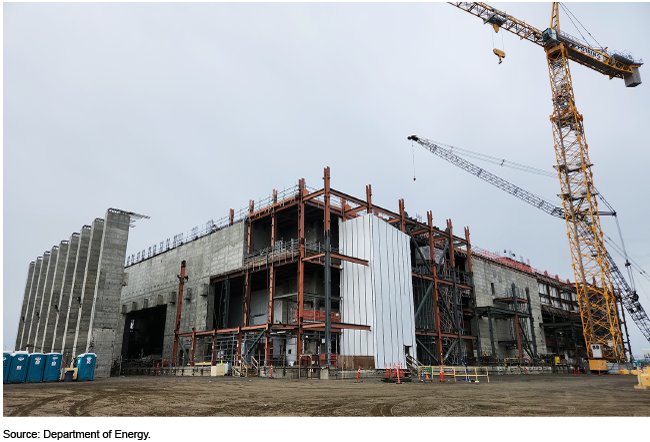Hanford Cleanup: DOE Should Validate Its Analysis of High-Level Waste Treatment Alternatives
Fast Facts
For more than 20 years, the Department of Energy has been building facilities to treat and dispose of radioactive and hazardous waste at its Hanford Site in Washington State. Waste treatment could cost about $341 billion and likely won't be complete until 2084.
DOE has been analyzing treatment alternatives for the most highly radioactive waste. However, the agency hasn't sought an independent review of its work—even though best practices recommend that an outside organization validates DOE's analysis. Given the enormous cost and schedule implications of this cleanup, we recommended that DOE do so.
High-level Waste Facility Construction at the Hanford Site in Washington State

Highlights
What GAO Found
The Department of Energy (DOE) plans to separate out and vitrify the most radioactive portion of the waste held in 177 underground tanks at its Hanford Site in the State of Washington. This high-activity waste—which DOE calls high-level waste, or HLW—represents about 72 percent of the estimated radioactivity in the tanks, though much of radioactivity will decay over the next 100 years (see fig. below). DOE's current plan for treating this HLW relies on a vitrification facility that will be part of Hanford's Waste Treatment and Immobilization Plant. This plant is partially complete and faces ongoing technical challenges.
In 2023, DOE released an analysis of alternatives that considered 24 options for treating Hanford's HLW. The analysis found that the life-cycle cost estimates for treating the HLW ranged from $135 billion to $5 trillion. The analysis also found that the current plan, as well as several other alternatives, would require a significant increase in annual funding (up to $8 billion a year) over the next 10 years. According to the analysis, none of the alternatives could complete HLW treatment by 2047—the treatment deadline set in legal agreements with environmental regulators—with the earliest estimated completion date for any alternative being 2061.
DOE plans to select an alternative for HLW treatment in the near future—though no timeline has been set—and has restarted some efforts to complete construction of the HLW treatment facility. According to DOE guidance and GAO best practices, before selecting an alternative, an independent entity should review and validate the analysis of alternatives process. However, DOE has not committed to obtaining an independent review to validate the portions of the analysis of alternatives process related to HLW treatment. Given the enormous cost and schedule implications of the decision, it is essential for DOE to take steps now to provide assurance that all viable alternatives for optimizing the tank waste treatment mission are considered.
Approximate Radioactivity in the Hanford Tank Waste over Time

Why GAO Did This Study
DOE oversees the treatment and disposal of about 54 million gallons of radioactive and hazardous waste at the Hanford Site in Washington State. Before treating the tank waste, DOE plans to separate it into two streams: (1) a high-activity portion, which DOE estimates will contain about 5 percent of the volume but more than 70 percent of the radioactivity; and (2) a low-activity portion, which will contain about 95 percent of the volume. Hanford's high-activity tank waste is mixed with hazardous components and, under current law, must be vitrified—a process in which the waste is immobilized in glass—prior to land disposal. DOE has been exploring alternative methods to treat the HLW portion of the waste.
Senate Report 117-39 includes a provision for GAO to assess DOE's approach to analyzing options for treating the HLW at Hanford. This report examines (1) DOE's current HLW treatment plans, (2) the results of DOE's analysis of alternatives for treating the HLW, and (3) the next steps that DOE plans to take in selecting a HLW treatment alternative. GAO reviewed DOE reports and data on the waste at Hanford, as well as DOE's current plans for treating it, and interviewed DOE officials.
Recommendations
DOE should obtain an independent review to validate the process of the analysis of high-level waste treatment alternatives at Hanford. DOE concurred with GAO's recommendation.
Recommendations for Executive Action
| Agency Affected | Recommendation | Status |
|---|---|---|
| Department of Energy | The Secretary of Energy should ensure that the Assistant Secretary for Environmental Management obtains an independent review to validate the process of the analysis of high-level waste treatment alternatives at Hanford. (Recommendation 1) |
In September 2024, in response to GAO-24-106989, DOE said that it will continue to assess HLW treatment alternatives and have these independently reviewed by December 2027. We will continue to monitor progress on this recommendation.
|
